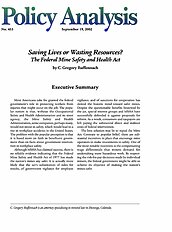Although MSHA has claimed success, there is no reliable evidence indicating that the Federal Mine Safety and Health Act of 1977 has made the nation’s mines any safer. It is actually more likely that the act’s substitution of rules for results, of government vigilance for employee vigilance, and of sanctions for cooperation has slowed the historic trend toward safer mines. Despite the questionable benefits bestowed by the act, special interest groups and MSHA have successfully defended it against proposals for reform. As a result, consumers and taxpayers are left paying the substantial direct and indirect costs of federal intervention.
The best solution may be to repeal the Mine Act. Contrary to popular belief, there are substantial incentives in place that encourage mine operators to make investments in safety. One of the most notable incentives is the compensating wage differentials that miners demand for undertaking more hazardous work. By respecting the risk-for-pay decisions made by individual miners, the federal government might be able to achieve its objective of making the nation’s mines safer.

